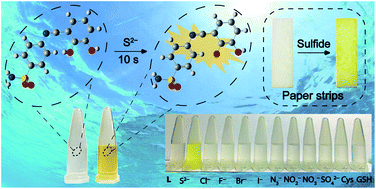A paper-based colorimetric chemosensor for rapid and highly sensitive detection of sulfide for environmental monitoring†
Abstract
In this study, we report on paper-based colorimetric detection of sulfide using a newly synthesized chemical acting as a chemosensor, based on the deprotonation mechanism. Paper strips were also fabricated and incorporated with the chemosensor for on-site monitoring. The presence of sulfide induced deprotonation of a hydroxyl group of the chemosensor, which eventually resulted in a distinct spectral change in the tube as well as a visible color change on a paper strip. The chemosensor showed a highly selective colorimetric response to sulfide by changing its color from colorless to yellow without any interference from a mixture containing other anions. Moreover, the chemosensor effectively differentiated sulfide from other thiols, including cysteine and glutathione. The chemosensor colorimetrically detected sulfide with a fast response time of 10 s under physiological conditions. Practically, the paper test strip enabled colorimetric visualization of as low as 30 μM sulfide and a good recovery in quantitative analysis in water samples. The introduced paper-based chemosensor is a promising colorimetric strategy with rapid, selective, and sensitive sensing abilities for sulfide monitoring in environmental water samples.



 Please wait while we load your content...
Please wait while we load your content...